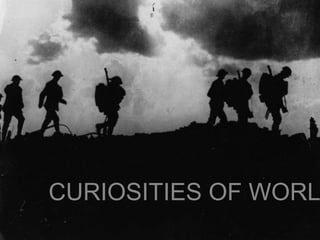
1
- 2. War on land Battles took place in France, Luxembourg and Belgium, called the Western Front; and in Russia, called the Eastern Front. There was also fighting on land in Italy, the Middle East and parts of Africa.
- 3. The beggining of tanks In September 1915 the British presented the first prototype of a tank called "Little Willie", but it was not until September 1916 during the Battle of Fiers-Courcelette that they were first used. 32 tanks called Mark I were used, were slow, easily damaged and not adapted to move through muddy terrain.
- 4. War at sea Naval battles mainly took place in the North Sea and the Atlantic. Britain used blockades to stop Germany from receiving supplies by sea. The shortage of steel forced the use of ships made of concrete (cement reinforced with ferrocement or reinforced steel).
- 5. The submarines, the great innovation in the marina. When war began, none of the belligerent powers gave much importance to submarines. Their uses were: coastal defense, exploration, and to a lesser extent for the attack. As the conflict progressed, it would become one of the main weapons of war and to attack commercial traffic, causing huge losses to its enemies.
- 6. War in the air Aeroplanes were new at this time. There were three different types of aircraft: Scouting, used for fighting; Bombers; and Reconnaissance, used for photography and directing artillery. Aerial attacks were very common in 1st World War, for this reason a fake Paris was built.
- 7. Propaganda The government needed to recruit lots of soldiers and wanted people to support them. Propaganda is used to try to make people think in a certain way.
- 8. How many people died in the Great War? Although the figures vary among historians, experts have indicated that there were 11 million soldiers and 7 million civilians. To date, it was the deadliest conflict by far, most of those who lost their lives did so as a direct result of the battle.
- 9. A third of all deaths were due to a pandemic You would think that those killed in combat were wounded with weapons or bombs, but a third of soldiers who participated in World War I succumbed to the Spanish Influenza. This brutal disease, one of the worst pandemics in history, spread rapidly around the world as soldiers carried it with them. It is believed to have been responsible for the deaths of between 50 and 100 million people. What was Spanish flu? Spanish Influenza (flu) was first reported in March 1918. It was called "the greatest enemy of all" because it infected half the world's population. It became known as Spanish Flu because Spain was one of the first countries to be hit by the disease.
- 10. Luxury German trenches Soldiers know that, in combat, the trenches are a pre-shelter place, but the Germans did not consider it that way. The trenches of the German army had beds, kitchens with cupboard, furniture, electric light, water tanks and even doorbell.
- 11. Underground warfare through the tunnels under the trenches An important role during World War I was the experienced miners, recruited to dig tunnels across the battlefield on the German and British sides. On June 7, 1917, one of the largest non-nuclear explosions in history occurred at the Battle of Messines. The British placed 455 tons of explosive under German lines, when they exploded they created 19 huge craters that caused 10,000 deaths among German troops. The largest diameter crater was 75 m. wide and 12 m. deep. Previously there had been a multitude of explosions through this method, but never of such magnitude. The explosion was of such power that it came to be heard in London.
- 12. Animals in the Great War Dogs played a very important role during World War I and were tasked with carrying orders, instructions and information across the battlefield attached to their bodies. More than 500,000 messenger pigeons were used and more than seven million horses died not only from clashes and heavy labor, but by the hand of men specialized in killing them when they were injured. The use of chemical weapons forced the army to wear masks, this was also applied for the animals
- 13. Communications During the combat at the front, telephone communication was complicated, because in the trenches where it was usually connected, contact was interrupted due to the precarious wiring and attacks. They then used flags of various colors, rockets, mirrors and signs, for example, to find out. As in ancient times they also communicated with pigeons and other animals, but the safest thing was always the soldiers, called runners, who transmitted information from one place to another. It is known that Hitler was one of them. Adolf Hitler at the timeDogs used as a form of communication
- 14. Medical advances X-ray technology helped surgeons to detect where a bullet had penetrated. Many operations were performed during the war thanks to this. Blood was first stored successfully during World War One. Doctors could now give blood transfusions to soldiers. Before, soldiers with burns, tissue damage and contagious diseases would have usually died. Left: an X-ray showing a bullet in the body. Right: blood transfusion apparatus, 1914-1918.
- 15. The impetus for plastic surgery occurred in World War I Dr. Harold Gillies was one of the leading pioneers of modern plastic surgery, during World War I he was responsible for reconstructing the disfigured faces of British soldiers wounded by shrapnel. He performed surgery operations on approximately 5,000 men, although some interventions ended in failure, his contribution to this medical specialty was enormous.
- 16. THE END BY SERGIO BLANCO GARCÍA